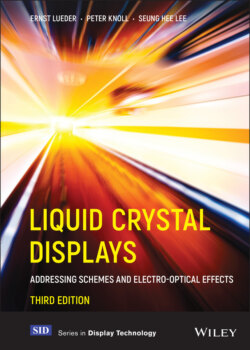Читать книгу Liquid Crystal Displays - Ernst Lueder - Страница 15
About the Authors
ОглавлениеErnst Lueder was born in 1932. At his graduation from high school he was awarded the ‘Scheffel’-prize for literary achievements. In 1962 he received his doctorate in electrical engineering, and in 1966 his Habilitation, which qualified him to teach theoretical electrical engineering. From 1968 to 1971 he worked for Bell Telephone Laboratories in Holmdel, New Jersey, USA, undertaking research into the design of miniaturized filters and communication systems, especially in thin film technology. He established laws for optimizing the dynamic range and the signal-to-noise ratio of two-ports.
In 1971 he was appointed a full professor at the Department of Electrical Communications, and was named Director of the Institute of Network and Systems Theory at Stuttgart University. He specialized in the design of hybrid thin and thick film circuits, the development of sensors, thin film transistors and flat panel liquid crystal displays, in the synthesis of circuits, in the theory of communication systems and in the optimization of systems. From spring 1991 he also headed a new DM80 million laboratory for the fabrication of flat panel displays. Research activities in this laboratory include TFT- and MIM-addressed TN, PDLC and GH displays, as well as bistable FLC and PSCT displays.
He retired in 1999. He was a member of the IEEE, and became an IEEE Fellow in 1985. As a member of the German Society for Information Technology, ITG, he was for two years a member of the society’s board of directors. He served in the Scientific Advisory group for the Heinrich-Hertz Institute in Berlin, and was chairman of this group for four years.
Starting in 1994 he participated as a member of the SID board of directors, as a director of the Mid-Europe chapter, and as vice-president for Europe. Further, he was a member of the SPIE, ISHM, FKTG, the German society for broadcast and television technology and the New York Academy of Sciences (NYAS). In 1991 he was awarded the order of merit 1st Class of the Federal Republic of Germany, and in 1998 he became a Fellow of SID and in 2009 received SID’s Slottow-Owaki Award.
During his career and retirement Professor Lueder has authored more than 200 publications on LCDs, network and system theory and optimization, and sensors and electro-optical signal processing.
Seung Hee Lee received his BS degree in Physics from Jeonbuk National University in 1989 and his PhD from the Physics Department of Kent State University in 1994. In 1995, he joined the LCD division of Hyundai Electronics (later named HYDIS Co.), where he did research on development of wide-viewing-angle TFT-LCDs with new liquid crystal devices until August 2001. During that time, he made a big contribution to the invention and commercialization of new wide-viewing-angle technology called ‘fringe-field switching (FFS)’ and introduced the FFS device to the public in Asia Display ’98, SID & IDW ’99, SID ’01, and IDMC ’02 for the first time.
In addition, his team has investigated unique and fundamental electro-optic performances of the FFS mode depending on electrode structure, cell parameters, and sign of LC’s dielectric anisotropy via journal and conference proceedings, and filed many key patents. His team proved the FFS mode was the only mode that can show high transmittance, low operating voltage, fast response time, wide viewing angle and pressure-resistant characteristics simultaneously, suggesting that the FFS mode can be applied to all kinds of high-end and high-image-quality TFT-LCDs.
In September 2001, he became professor in Department of Polymer Nano Science and Technology of Jeonbuk National University. Since then, he has worked on the development of new electro-optic materials and devices for displays and photonics. He was awarded ‘King of Invention’ twice while he was in industry. He has also received several major awards, such as the ‘SID Fellow’ in 2008, the ‘SID Special Recognition Award’ in 2012, and the ‘Merck Award-Major’ from the Korean Information Display Society in 2013, and the ‘Jan-Rajchman Prize’ in 2016.
Peter Michael Knoll was employed at Robert Bosch GmbH, Karlsruhe, Germany, from 1980 until his retirement in 2006. He is now a retired Associate Professor for Driver Assistance Systems and associated Human Machine Interaction at the KIT, formerly University of Karlsruhe, Germany.
He was head of the Bosch Companies Laboratory for Car Displays from 1980 until 1995; General Manager at ADT Inc. (Applied Display-Technology GmbH), Stuttgart, Germany, until 1999; Vice President Development New Products, Driver Assistance systems Business Unit, Robert Bosch GmbH, Leonberg, Germany, until 2007; Associate Professor for Display Technologies, Faculty of Electrical Engineering University of Karlsruhe, Germany, from 1988 to 2009; and Associate Professor for Automotive Information Systems, Driver Assistance Systems at the KIT, Germany, until 2013.
